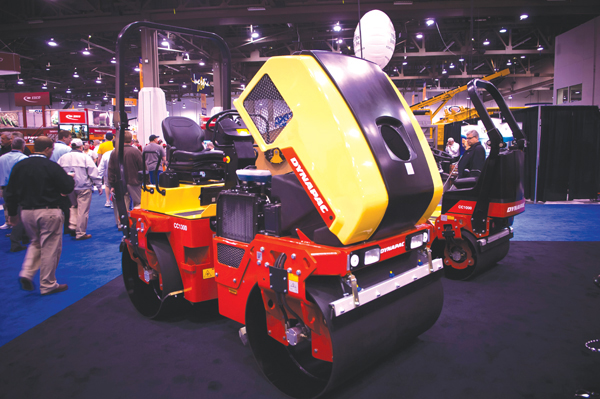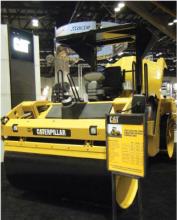An array of new models has increased competition in the market for compact asphalt compaction products - Mike Woof reports

Ease of use, ease of servicing and low operating noise and emission are key features of the redesigned Dynapac compact twin drum rollers
An array of new models has increased competition in the market for compact asphalt compaction products - Mike Woof reports
The huge investment in infrastructure in Brazil, Russia, India and China (BRIC) is the focus for much of the machine production and sales from the major manufacturers. It is worth noting too how customers in the BRIC nations are often keen to use good quality machines from the premium manufacturers because these offer better performance, reliability and resale value, providing a better return on investment overall.
Amongst US and European rental firms there is a need to update their fleets after several years of holding back on new equipment purchases due to the recession, with data from analysis specialist
The Switzerland-based Ammann group has been offering compaction machines of all types for many years and says that its compact1-2.5tonne tandem rollers are designed to offer full-flush compaction on the right and on the left. These machines also feature double traction at front and rear and double vibration at front and rear. The design of the drums allows compaction work tight against kerbs and walls and the firm says that as a result, there is no need for subsequent compaction passes using smaller hand-controlled units.
German company BOMAG has long been a major player in the compaction sector and recently introduced its revised compact tandem units, which form a major part of the firm's overall sales worldwide. This is the fifth generation of BOMAG's compact rental-orientated asphalt rollers in the 1.5-1.7tonne class, with successive upgrades having made major gains in performance and reductions in running costs. These models have not merely been facelifted though and around 90% of the components are new.
The range has been developed over a three year period with considerable input from customers, following the unveiling of the original prototype at the
The standard models are the BW80 AD-5, BW90 AD-5 and BW100 ADM-5 with drum widths of 800mm, 900mm and 1m respectively. There is also the BW100 ACM-5 combination roller with one 1m wide drum, and two clear-sided rollers with drum widths of either 0.9m or 1m. These last two units are the BW90 SC-5 and BW100 SC-5 and have drums offset by 60mm, allowing working widths of 0.96m and 1.06m. There is also a
Maximum speed while the vibration system is in use is 4.5km/h although the machines can be driven at up to 10km/h when being moved around site, gains of 25% over the previous generation models. Jason Davey, sales manager at BOMAG GB added, "The higher travel speed increases productivity and works in combination with the intelligent vibration control (IVC). The IVC is a new feature and it can be set to automatically start vibration if the speed exceeds 1km/h. The system also switches off the vibration if the travel speed is too high." A key feature picked up by the customer focus research includes extensive legroom, which Davey added allows sufficient space for long legged operators with big feet and wearing boots. The machines also have good all round visibility due to the impact-resistant composite hood and narrow articulation area with a 30% better field of view, which maximises visibility to the front and bottom rim of the drum compared with the previous generation machines and the old BW80 in particular. Davey said, "The operator no longer needs to lean out to see the lower edge of the drum." The drums are suspended or connected to the frame on one side only, which allows an operator to compact on both the left and right sides close to a wall or kerb. The new control layout features a Smart Drive steering wheel and multi-function control lever. The sprinkler system comes with a sophisticated membrane pump, a water-saving concept with triple filtering, wind-protected nozzles and automatic sprinkler control. This set up is said to ensure that the drums receive sufficient water even in strong winds or when the roller is on an incline. The machines retain some proven components though, such as the exciter system and articulation joint, to ensure reliability. Other features include a storage compartment under the seat for tools, individual vibration switches as standard, large lashing rings and a single lifting point. Options include a ROPS frame, a battery disconnect and a cutting disc.
But BOMAG is not standing still even with the launch of the high specification compact asphalt rollers. Other capabilities are planned and BOMAG intends to offer its sophisticated telematics technology for the compact asphalt rollers, which will include remote monitoring and geo-fencing capabilities. Davey added, "In the near future we will have BOMAG's intelligent compaction tool in the compact machines." Also new this year for the compact asphalt roller market is the revamped range from Dynapac, again pitched directly at the rental market. The company has recognised that maintenance is a key issue in the rental sector and the new designs are said to be much easier to service than before. With rental machines sometimes being used by inexperienced operators, ease of use is another key point that Dynapac has been keen to ensure. The improved design also ensures low vibration to the operator's seat as well as maximizing all-round visibility. Because of the new exhaust and noise emission regulations, the firm has selected liquid-cooled Kubota diesels for the new CC1100, CC1200 and CC1300 models. These power units are said to offer low fuel consumption together with the necessary low emissions and operating noise.
The top of the Dynapact compact asphalt roller range is the CC1300, which has an operating weight of 3.9tonnes. Meanwhile the CC1100 has an operating weight of 2.4tonnes. Dynapac offers the three basic machines in a choice of two configurations: with dual steel vibrating drums or as a combiversion fitted with one vibratory drum and four rubber tyres. For the combi versions the rubber tyres are operated in pairs by separate drive motors, a design feature that reduces the risk of marking newly laid asphalt when making sharp turns. The machines are equipped with large diameter drums and the company says that this design allows effective operation, even on soft asphalt compounds. In addition, the ratio of drum diameter to static linear load also helps reduce the risk of cracks. Meanwhile good clearance at the drum edge allows compaction close to walls or high kerbs. Although the rollers are engineered primarily for asphalt compaction duties, the CC1300 can also be used for compacting sub-bases and base courses.
In the face of strong competition, Hamm also continues to update its compact asphalt rollers. The firm launched totally revamped machines only a few years ago so these latest versions are upgrades, with the key change being new engines that meet the Tier 4Interim/Stage IIIB emissions legislation. As with the BOMAG and Dynapac machines, Hamm has also selected Kubota diesels to power the new Compact Line. Externally the machines remain similar to the earlier versions but these new models have undergone a series of significant changes to boost performance and productivity. The upgraded Compact Line range includes models with drum widths from 800mm to 1.4m and all the machines are said to be easy to use and service. Included in the range are the HD14VV with its 1.4m wide drums, the HD13VT combination roller with its 1.3m wide smooth drum at the front and four pneumatic slick tyres at the rear, the HD12VV with its 1.2m drums, the HD10CVV with its 1m wide drums and the HD8VV with its 800mm drums.
Volvo Construction equipment has also improved its compact asphalt compactors in recent years. The DD14S is the most compact of Volvo's tandem vibratory rollers, with an operating weight of 1.545tonnes. However, despite its small size the DD14S is said to offer the same high vibration frequency found in larger models, allowing high working speeds and improved productivity. The compactor features 900mm wide drums at the front and rear, with front vibration. Meanwhile the 2.6tonne DD24 double-drum machine weighs in at 2.6tonnes and features two 1.2m wide drums. This machine features two vibration frequencies, 55Hz and 67Hz, for different compaction applications.










